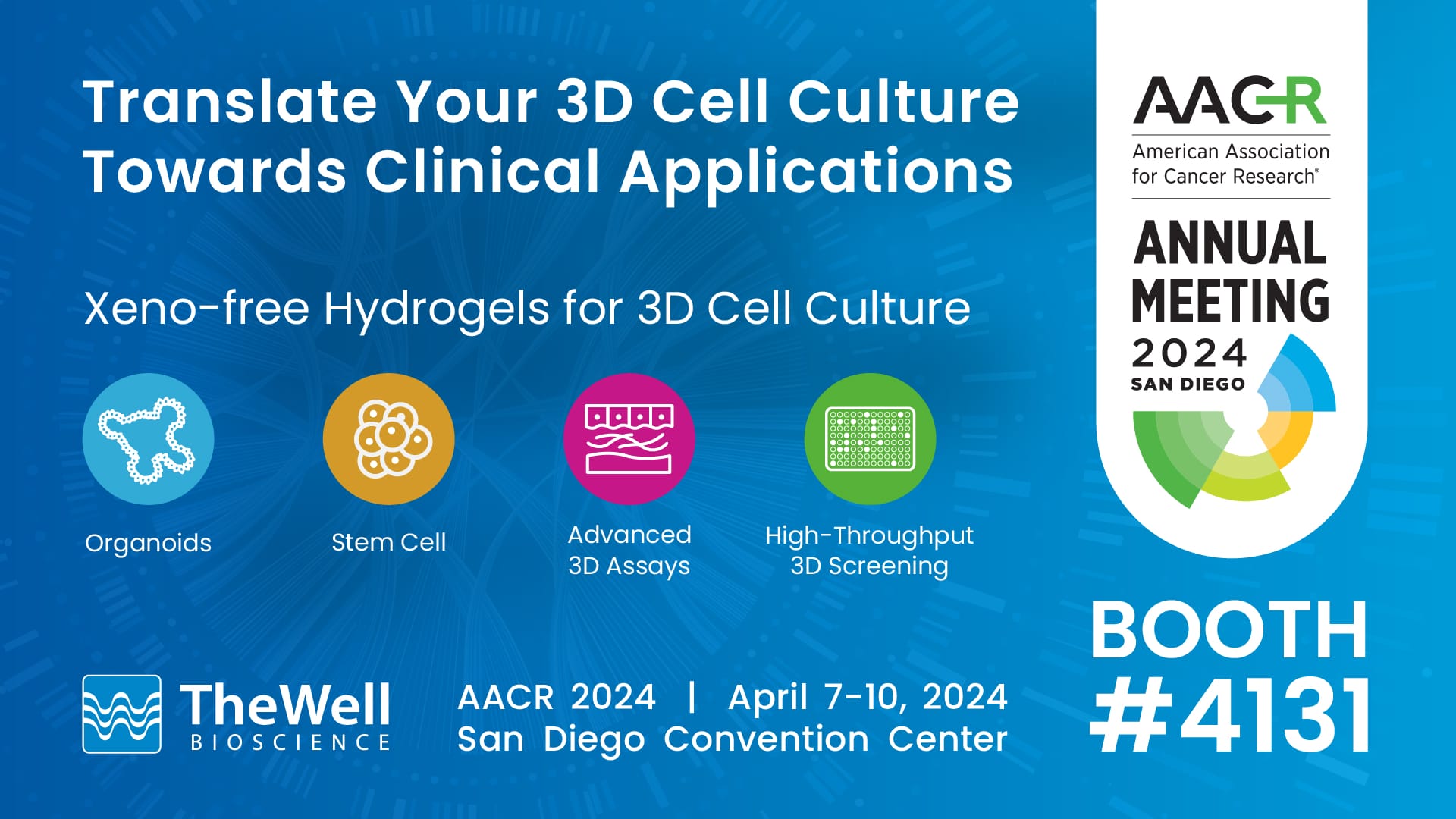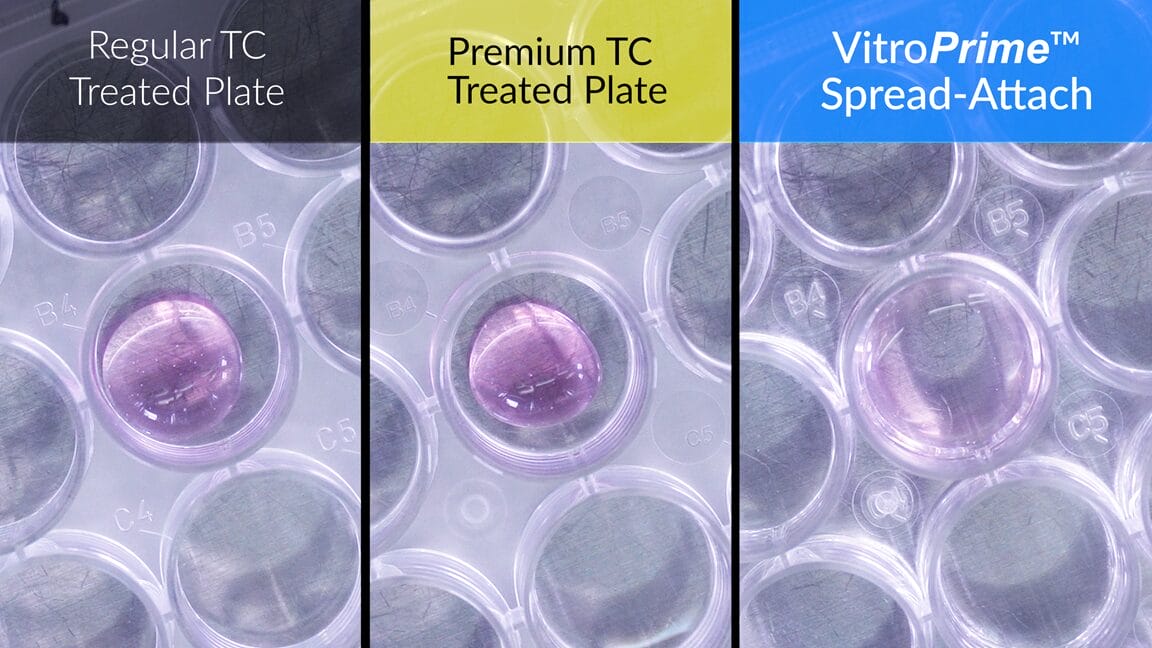Conferences, News
American Association for Cancer Research (AACR) – 2024

We are excited to attend again this year’s AACR 2024 (American Association of Cancer Research) in San Diego, California, hosted at the San Diego Convention Center. Please stop by booth #4131 to speak with our team members about how our VitroGel® family of animal-free hydrogels can replace animal-derived ECM for your 3D cell culture research.
AACR 2024 – Booth #4131
We would love to meet you. Want to schedule a time with our team at AACR or can not attend? Please fill the form and our team will be happy to assist you in any 3D cell culture applications with our VitroGel hydrogels.

Are you presenting a poster or giving an oral presentation at an upcoming conference using VitroGel®? If so, you’ll be eligible to receive a gift.
Please let us know if you are presenting a poster or giving an oral presentation using VitroGel hydrogels at an upcoming conference. We help promote your poster session, and you will be eligible for a gift card.
To apply, please click the button below.
Submit your PresentationPOSTER Sessions
Click to expand to view more details on the poster session presented by collaborators/users of VitroGel.
https://www.abstractsonline.com/pp8/#!/20272/presentation/8784
Date: Tuesday, April 9, 2024
Time: 9:00 AM – 12:30 PM
Session: Models to Study Immune Cells in the Tumor Microenvironment
Poster Info: Section 10
Poster: 4209 / 11 – Unraveling the effects of the microenvironment on glioblastoma multiforme invasiveness using a xeno-free 3D hydrogel platform
Abstract
Glioblastoma multiforme (GBM) is a grade IV astrocytoma and the most common type of adult brain malignancy. The overall survival of patients diagnosed with GBM is less than 5 years. Therefore, it is imperative to understand the mechanisms contributing to GBM progression, invasiveness, and survival. This study aimed to evaluate the effect of the extracellular matrix (ECM) on GBM cell invasion by performing the traditional invasion assay as well as novel in vitro invasion assay strategies. A significant challenge with in vitro cell invasion assays is the use of animal-based ECM: the components of animal-based ECM are not characterized; the batch-to-batch variability of animal-based ECM can influence experimental findings and affect potential clinical applications; and the temperature-sensitive operation protocols make the use of animal-based ECM time-consuming and difficult for automated high-throughput assays. These challenges can be circumvented using VitroGel®, a synthetic xeno-free, bio-functional hydrogel resembling the physiological ECM with tunable biophysical and biochemical properties. In this study, we harnessed the properties of the synthetic xeno-free hydrogel system to examine how different mechanical strengths and functional ligands as well as cytokines and serum within the hydrogel matrices or in the outer well, affect GBM cell invasion. The results indicated that adjusting the mechanical strength of the ECM system affects GBM cell invasion. We further showed that the bio-functional ligands within the hydrogel matrix, such as matrix metalloproteinases, RGD peptide, and others, stimulated cell invasion. This finding exemplifies the importance of using a well-characterized ECM system given that it is difficult to evaluate how specific ECM components contribute to cell invasion using the undefined animal-based ECM. Since the composition of the hydrogel system is chemically defined, we could further control the cytokine milieu within the matrix to understand how the ECM composition affects cell migration. To demonstrate this, we added the cytokine TGF-β1 to the hydrogel and examined GBM cell invasion. Indeed, we showed that adding TGF-β1 to the synthetic VitroGel enhanced GBM cell invasion, thus illustrating that incorporating factors inside the matrix is a powerful method to evaluate chemotaxis. Altogether, this study demonstrates the potency and flexibility of using a xeno-free hydrogel for a myriad of invasion assay applications.
New products we will be showcasing:
The VitroGel-Based Invasion Assay Kits are powered by VitroGel® hydrogels (versatile, xeno-free, bio-functional hydrogels that closely mimic the physiological extracellular matrix) and coupled with our premium quality VitroPrime™ Cell Culture Inserts, allowing more accurate and consistent invasion and migration studies than animal-based ECM.
VitroPrime™ Cell Culture Inserts. It closely mimics the in vivo environment, promoting enhanced attachment, growth, and differentiation of a wide range of cell types.
We will showcase new laboratory cell culture inserts and plates for laboratory automation.
VitroPrime™ Spread-Attach Plate. The plate is engineered to provide a seamless and uniform environment for your hydrogel-based experiments, thus eliminating the edge effects for flat gel surfaces.
We will showcase new laboratory cell culture plates for laboratory automation.
Some of the many 3D cell applications we will be showcasing:
- VitroGel® Organoid Recovery Solution Our newly released non-enzymatic cell harvesting soltuion to recover intact organoids/cells from an animal-based ECM or our VitroGel hydrogels.
- On-Demand Webinar
“Comparative Study of Animal-derived ECMs and VitroGel® Hydrogel for hiPSC Maintenance and Intestinal Organoid Generation” - Application Note
“Quick and Efficient Organoid/Cell Recovery from Animal-Based Extracellular Matrix” - Application Note
“Xeno-free Organoid Generation Workflow for Stem Cell Spheroids Using VitroGel STEM and VitroGel ORGANOID Hydrogel System”
Stop by to discuss how our xeno-free VitroGel can replace animal-based ECM for PDX or CDX models.
- Application Note with HD Bioscience / a Wuxi Apptech company
“Cell Line-Derived Xenograft Using Xeno-Free VitroGel System in Comparison to Animal-based Extracellular Matrix” - Application Note with Hera Biolabs
“Comparing the Xeno-Free VitroGel to Animal-Based Matrigel for Xenograft Studies”
- Application Note with Molecular Devices
“Automated Dispensing, Monitoring and Assay Development of Hydrogel-based 3D Cellutlar Model” - Application Note (Protein Fluidics)
“Automated Biomarker Assays for 3D Cell Models on the Pu·MA System with Xeno-free VitroGel Hydrogel”
- Application Note (Aquarray)
“Generation of Tumor Cell Spheroids in Miniaturized Nanoliter Droplets Using Xeno-free VitroGel Hydrogel Matrix”
- On-Demand Webinar
“Advanced Cell Mobility Studies Using the Xeno-free Vitrogel®-Based Cell Invasion Assay Kits” - Application Note
“Using the Xeno-free VitroGel-Based Cell Invasion Assay Kits to Perform both Traditional and Complex Cell Mobility Studies“ - Application Note
“3D Spheroid Invasion Assay With Xeno-free, Bio-Functional VitroGel Hydrogel Matrix“ - Application Note
“3D Invasion of Glioblastoma Cells in VitroGel Hydrogel System“ - Application Note
“Using the VitroGel Hydrogel System as a Versatile Platform for Invasion Assay”




